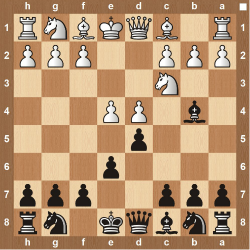
The Winawer Variation is one of the main lines in the French Defense for black and begins with the moves:
1.e4 e6
2.d4 d5
3.Nc3 Bb4
Nc3 helps support the e4 pawn which is currently under attack. Bb4 pins down the white knight to the king and renders is useless to defend against the dxe4 attack that black is threatening. White can’t continue with normal moves such as Nf3 or Be2 as they both lose to dxe4. White must counter attack black’s bishop or move the pawn out of harms way. Below are the different options that white may try to play against the Winawer Variation.
4.e5
This is the main line for white. It extends the center control, gets the e-pawn out of harms way, and stops black from developing the knight to the natural f6 square. Black will respond with 4…c5 attacking the d4 pawn now. White has many options here:
5.a3 This attacks the bishop and puts black to the test. The main line is for black to take Bxc3 but it’s easier for black to disrupt the center pawns by taking cxd4. This leaves white with a pawn on e5 with little protection. Play may continue 6.axb4 dxc3 7.bxc3 Qc7. Another alternative for white is to ignore the bishop on b4 and play Qg4. This is a dangerous and aggressive line that some skilled players will try.
5.Bd2 Many players don’t like their pieces being pinned down so they stop it at all costs. That’s exactly what this move does for white. Black should continue with 5…Ne7 (since the f6 is under attack) and prepare for Nf4.
5.dxc5 Black will continue with Ne7 knowing that at anytime black can take the material on c5 and there is no way for white to defend it.
4.exd5
The exchange variation isn’t common but some players don’t enjoy the French and will try to exchange material to avoid the main lines. Black will take back with 4…exd5 and then develop as normal with different options as 5…Nf6 (since it’s not under attack by e5 pawn) or 5…Nc6.
4.a3
While not a good move for white it is fairly common as players like to attack pieces that are pinning them down. This fails because no material has entered to help with the e4 pawn. Black can play 4…Bxc3 and after 5.bxc3 black gets a gift with 5…dxe4.
4.Nge2
This looks like it does not defend the e4 square but it does indirectly by replacing the knight on c3 if it falls. Black should still continue by taking with 4…dxe4. A common theme in the french defense is for black to aggressively attack the central pawns of white. It puts white on their back foot and gives black some very solid attacking lines.
Play usually continues with 5.a3 attacking the bishop followed by 5…Bxc3 6.Nxc3 Nc6. Black should not try to hold onto the pawn with 6…f5 or 6…Nf6. Playing f5 extends too far in front of the king’s safety and Nf6 is easily met with Bg5 pinning down the knight. Better is Nc6 which attacks more material for white. Now if white tries to defend, then black can play Nf6.
4.Bd3
This is a very defensive play for white but it does defend the pawn on e4. Black should still continue with 4…dxe4. White will recapture 5.Bxe4 followed by black’s Nf6. The bishop is under attack and black is free to develop his pieces while maintaining both of his central pawns.
4.Bd2
You should know that this is one of the weaker moves for white so if you are playing as black, be prepared to attack. The move order will be the same 4…dxe4. Play usually continues 5.Nxe4 Qxd4 6.Nc3 Nf6 and black has a very good game.
Below you can watch all of the lines referenced on this page and see a much deeper analysis on the Winawer Variation.